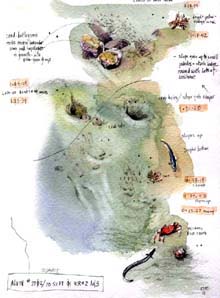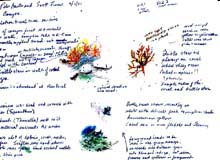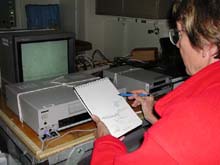
This sketch, by M.J. Brush, attempts to capture a portion of George's Bank Canyon and some of the organisms found there during the Alvin dive on September 10, 2001. Click image for larger view.
The Art of Exploration
Art historians have puzzled for hundreds of years about how to decipher what could be considered the first "scientific illustrations" which were recorded on cave walls in Altimara and Lascaux France. These drawings, produced by primitive humans, depict many animals, including horses and bison. The drawing surface was stone; the materials were charcoal used to produce the color black, ground up shells to produce white, and red earth to produce the color red. Certainly, these were some of the first attempts made by humans to communicate with others and the language was quite simply, art.
Another early science illustrator was Leonardo da Vinci. It was da Vinci who first dissected the human body in a systematic way, recording and illustrating everything he found. It was also da Vinci who drew the first design for a helicopter and a diving bell.
Herbals were one of the earliest uses of art in the service of science. Artists illustrated an herb and doctors recorded the pharmacology of plants. It was herbals that formed the first substantial "reference library" of scientific illustrations.
With the invention of the printing press, Europeans began writing and illustrating the natural world. Communication of this information through scientific publications began in earnest. From the 1500s on the Portuguese, Spanish, and English explored the world. Artists often accompanied them on expeditions. Vancouver explored the west coast of the United States with a science illustrator. Sir Walter Raleigh employed John White to draw species from the Chesapeake and Virginia area. Mark Catesby was sent from England in 1724 to explore the East coast of "the colonies" for Sir Hans Sloan in England. He water colored over 220 plates and sent back countless specimens during his four-year collecting journey. During the Lewis and Clark Expedition, Merewether Lewis recorded his discoveries though his own scientific illustrations. The work of these men and their artists is interesting to look into. They were the first explorers to chart and draw the natural history of the United States. The Challenger Expedition of 1874 was one of the first concentrated deep ocean explorations. It was completely underwritten by the British government and its explorers were charged with mapping the oceans of the world. This four-year expedition, which would cost $10 million to conduct today, produced 50 volumes of scientific writing and illustrations over a 10-year period. It is known as one of the most factual and complete documentation of the oceans with its specimen collections still archived and curated to this day.

Preliminary sketches of deep sea corals made from images collected by Alvin during its descent into Georges Bank Canyon. Click image for larger view.
Today’s scientific illustrator works for scientists, universities and colleges, book publishers, conservation groups and a myriad of others wishing to have portions of their work communicated to others through art. Often, specimens are brought to scientists damaged or crushed. A camera cannot repair that damage—an artist can. Oftentimes, there are very subtle and specific characteristics that delineate one species from another and it is the job of the artist to highlight and bring out these unique features. Scientific illustrators can also depict internal morphology of organisms where the hand-held camera focuses only on the external characteristics. Scientific illustrators produce most of the diagrams in science textbooks. In a very real sense, scientific illustrators become the "eyes" of the scientists.

Scientific illustrator M.J. Brush reviews video tapes taken by Alvin during its descent into Georges Bank Canyon. From these images she creates a composite sketch of the features and organisms which make up the "landscape" of the ocean floor. Click image for larger view.
Two scientific illustrators are accompanying the scientists on the Deep East Voyage of Discovery with the primary objective of "landscaping" the sea floor off George's Bank. Because photographs cannot possibly capture a full image of a large portion of sea canyon walls at George's Bank, the artists are reviewing video tapes recorded during Alvin dives in an attempt to piece together single video images into a mosaic that will become a portrayal of a deep-sea canyon. Hours and hours of videotapes are reviewed to sketch a very small section of the canyon wall. Sketches depict the topography of the canyon and include images of organisms recorded on the tapes. According to M.J. Brush, one of the scientific illustrators aboard the Deep East Expedition, "Scientific illustrators have a curiosity of how things work and how they are put together. It is most interesting to uncover the symmetry, design, and purpose of structures. It is indeed the key factor that makes it such an interesting career choice." It is interesting to note that illustrators were onboard the Challenger Expedition creating images of previously unknown ocean dwellers. So too, artists on board Leg One of the Deep East 2001 Voyage of Discovery are working closely with scientist to document and record for mankind areas of the ocean floor never before seen by the human eye. Some of the preliminary drawings of the Deep East Voyage of Discovery are captured here.
Sign up for the Ocean Explorer E-mail Update List.
































